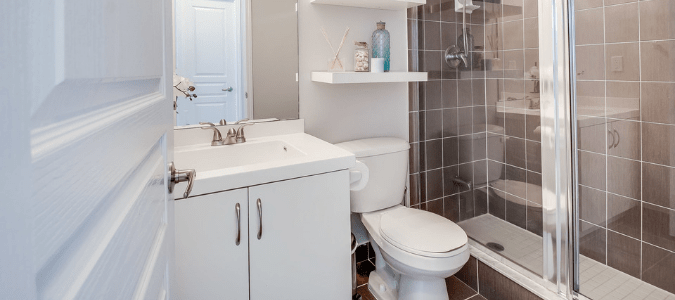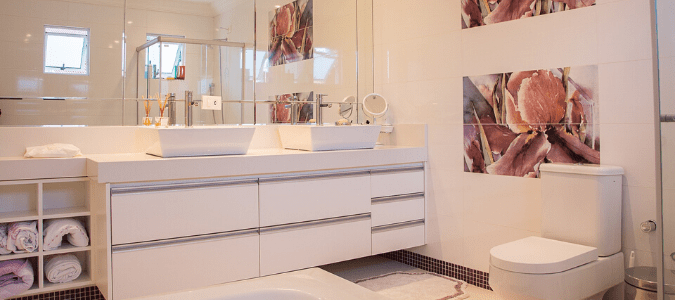If you find water pooling on the floor around your toilet, you want it fixed as soon as possible. Any water leak is cause for concern. Water leaks can damage flooring, baseboards and cabinets and drive up utility bills. Fortunately, if you find your toilet leaking at base, it can be fixed relatively easily by a qualified plumber. This is also a job that capable DIY homeowners can often handle on their own.
If your toilet is leaking at the base, it’s important to make sure you know exactly where the water is coming from. Sometimes, you’ll see water on the floor around the toilet and assume it’s coming from the base. But really, it’s dripping down from the tank. It may also be coming from the water supply lines that run between the toilet and the wall.
One way to check that the water is actually leaking from the base of the toilet is by wiping up all the water with a towel and then flushing the toilet. Watch carefully to see where the water is coming from. If it’s leaking from the base, it will ooze out from that point when the toilet flushes.
The reason that toilets leak at the base is usually related to one of two things. First, the mounting bolts that fasten the toilet to the floor may need tightening. Second, the wax ring that makes a tight seal between the bottom of the toilet and the drain pipe in the floor may need replacing.
Tightening the Mounting Bolts
Let’s look first at the mounting bolts that attach your toilet to the floor. These bolts poke up out of the floor, on either side of the drain pipe that leads to the sewer. When a new toilet is installed, the mounting bolts fit through two small holes on either side of the base of the toilet. Then, washers and nuts are threaded onto the bolts and tightened to secure the toilet in place. Sometimes, but not always, the bolts are then covered by caps.
Over time, the nuts that tighten the toilet onto the mounting bolts can loosen. If you sit on your toilet and it moves, rocks or makes a clunking sound, it isn’t tightened down as securely as it should be. Rocking and clunking aren’t the only problems that can happen when these bolts get loose. The other, bigger issue that can happen is a water leak every time the toilet flushes.
Tightening the bolts can solve the issue, but it’s important that you don’t over-tighten them. Over-tightening these bolts can strip them, break the toilet flange, or crack or even shatter your toilet. That’s why this seemingly simple adjustment may be better handled by a professional.
Replacing the Wax Ring
Now let’s consider the wax ring that seals the connection between your toilet and the drain pipe. If you were to disconnect your toilet, lift it up and turn it over, you would see the large, circular opening in the bottom of the toilet. This opening is surrounded by a ring of thick, sticky, yellowish wax. When this wax ring is working properly, it creates a waterproof seal between your toilet and the drain pipe that leads out to the sewer.
Over time, though, the wax ring can wear out. It can get dried out and crack, or develop thinner spots where it isn’t making a good seal anymore. When the wax seal on a toilet isn’t working well anymore, you may also smell sewer gasses escaping. This smell is something like rotten eggs or sulfur.
Unfortunately, tightening the mounting bolts won’t help if the wax ring is getting too thin or dried out. This is another reason that it’s a good idea to call in a professional when your toilet is leaking at the base. A licensed, reputable plumber can determine the exact source of the leak and fix it.
Some people can replace the wax ring themselves. To do so, you’ll need to buy a new wax ring from your local hardware or home improvement store. Set out a tarp or some thick towels on the bathroom floor and put on some rubber gloves to protect your hands.
The first step for replacing the wax ring on your toilet is to turn off the water at the toilet’s water supply lines. Then flush the toilet to get as much water as possible out of the tank. Next, disconnect the water supply lines from the toilet, and then unscrew the tank from the toilet bowl and set it aside.
The next step is to unscrew the nuts from the mounting bolts at the base of the toilet. Then, use a utility knife to cut through any caulking around the base. Then you should be able to rock the toilet from side to side to loosen it. Once it’s loose, you can lift the toilet off the mounting bolts and turn it on its side.
You’ll want to set the toilet on your tarp or towels, because there will still be some residual water that drips out. You should also stuff a rag into the open drain pipe to block sewer gasses from leaking out.
Wearing rubber gloves, use paper towels and spray cleaner to clean the whole outside and underside of the toilet. Then use a putty knife to scrape off as much of the thick wax ring as possible, and scrape it off into a plastic trash bag. Once the old wax ring is off, you’ll replace it with the new one, pressing it firmly into place.
While the toilet is disconnected, it’s a good idea to check the flange to make sure it’s still in good shape. The flange is the circular plastic piece that fits into the floor, just inside the drain pipe. Sometimes a toilet starts rocking on its base because the flange broke or came loose. You may need to tighten the bolts that screw the flange into the floor. Alternatively, you may need to replace the whole apparatus with a new flange and screws.
It can be hard to know which parts of your toilet are failing and causing the leak. If you aren’t sure how to fix your toilet leak or it feels like too big of a job, contact a plumbing professional. A good plumber can replace any broken parts and get your toilet working properly again.
Toilet Valve Leaking: What to Do
The shutoff valve to your toilet is the little metal valve located just below and behind the tank. It connects to the water supply line that goes into the wall. One sign that your toilet valve is leaking is that your tank isn’t filling but you can hear water running. When you find your toilet valve leaking, you’ll need a screwdriver and some pliers to fix it. If you don’t want to try fixing it yourself, you can always call in a professional plumber to tackle this relatively simple job for you.
When a toilet valve is leaking, it’s usually because it’s been a long time since it was turned off and back on again. Valves wear out over time. They wear out either due to mineral deposits building up inside from hard water or from the washer within the valve getting too brittle to make a tight seal.
Sometimes, fixing a leak at the shutoff valve is as simple as using pliers to tighten the packing nut on the valve. Be careful when you do this, since you don’t want to damage the packing nut or over-tighten it. Just use the pliers to do a slow and careful one-eighth turn, and see if that fixes the leak.
If that doesn’t resolve the leak, you may need to take the shutoff valve apart and replace the rubber washer. To do this, be sure to shut off the main water to your house first. When you have taken the valve apart to access the washer, you can try flexing it to see if you can make it more supple again. But, it’s usually better just to replace it.
Since these rubber valves come in several different sizes, it’s a good idea to take the old washer to the hardware store with you to make sure you get the right size. You may wind up needing to replace not just the washer, but the whole shutoff valve. This is a relatively simple job, but it can be a challenging one if you’ve never done plumbing jobs before. You may want to call in professional help to make sure it’s done quickly, thoroughly and correctly.
Toilet Leaking from Bottom of Tank
When your toilet is leaking from the bottom of the tank, it typically means there is a rubber washer or gasket that has worn out and is no longer creating a good seal. Whenever you flush the toilet and the tank empties and then refills, the worn-out washer or gasket lets a little water seep out. Over time, this small leak will become bigger and bigger. To avoid high water bills and potential damage to your home, it’s a good idea to fix the leak as soon as possible.
You may be able to fix it yourself without too much trouble. First, turn off the water supply to the toilet at the wall and then flush the toilet to empty the tank. You can use a sponge or towel to soak up any residual water left in the bottom of the tank. Then use a wrench to disconnect the water lines from the tank and then the tank from the rest of the toilet.
Once you have disconnected the tank, you can lift it off and lay it down on some towels. The large, circular washer located on the bottom of the tank, right in the center, is the spud washer. If this is the source of the leak, you can easily replace it with a new spud washer from the hardware store.
Leaks can also come from the smaller washers on the bolts in the bottom of the toilet tank. To replace these washers, unscrew the nuts from the tank bolts and slide off the old washers. If there’s leftover residue, you may need to scrape it gently off the bolt before sliding new washers on and reconnecting everything.
An experienced professional plumber can handle both minor and complicated toilet leak issues. Often it’s better to hire a pro because they can accurately diagnose the problem and then get it fixed both quickly and completely.
ABC Can Repair Your Toilet
A toilet that leaks when flushed can quickly lead to messy problems. If you’re in need of toilet repair, contact ABC Home & Commercial Services. Our licensed professionals will efficiently diagnose and fix your toilet problem.



